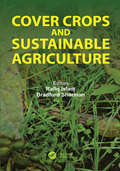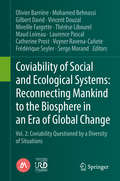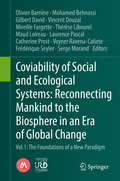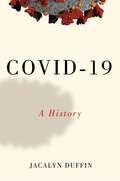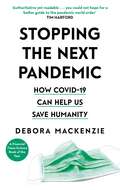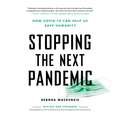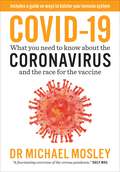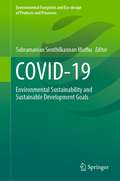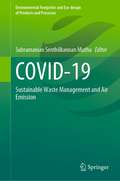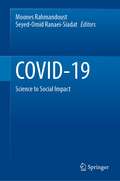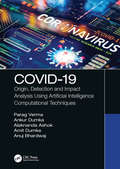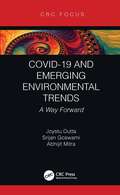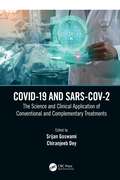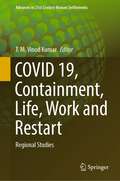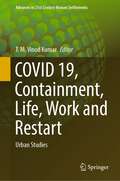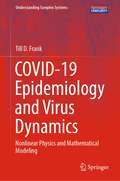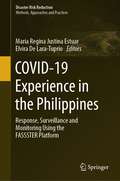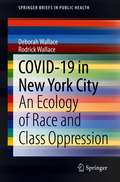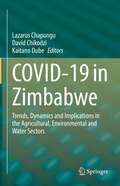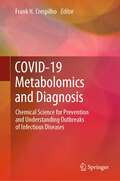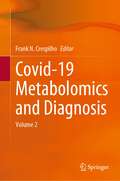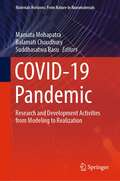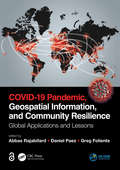- Table View
- List View
Cover Crops and Sustainable Agriculture
by Rafiq Islam and Bradford ShermanThis book will not serve as the "encyclopedia of cover crop management," but it’s close. The benefits of a wide range of individual cover crops and blends/mixes for specific agronomic crop rotations and geographic locations are included. Descriptions, photographs, and illustrations show how cover crops look in the field, including plant height, leaf architecture, and rooting patterns. Long term benefits are described for soil health, soil structure, water quality, nutrient contributions, soil biodiversity, air quality and climate change. In addition to the "whys" of cover crop use, the book includes details on the "hows:" how to choose cover crops for specific applications and locations; how (and when) to plant; how to manage and maintain the cover for maximum benefit; and how and when to terminate. Planting options include: drilling/planting between rows of an agronomic crop at planting time, or when the crop is short (i.e. corn in early June); "aerial" seeding with an airplane or high-clearance machine shortly before the crop reaches maturity; and drilling/planting immediately after harvest of the agronomic crop. Selected cover crops (blends) can help with pest and disease management. Cover crops are an economic input with an expected return on investment, similar to pesticides and fertilizer. As part of a continuous no-till system, cover crops provide long-term biological, chemical and structural benefits. The resulting increase in soil organic matter means the agronomic crop yields benefit from better water infiltration and water holding capacity, greater availability of nitrogen and other nutrients, deeper rooting, and increased soil microbial activity in the root zone.
Covering and Surrounding: Two-Dimensional Measurement
by Glenda Lappan Elizabeth Difanis Phillips James T. Fey Susan N. FrielNIMAC-sourced textbook
Covering and Surrounding, Two-Dimensional Measurement
by Glenda Lappan James T. Fey William M. FitzgeraldNIMAC-sourced textbook
Coviability of Social and Ecological Systems: Reconnecting Mankind To The Biosphere In An Era Of Global Change Vol. 1 : The Foundations Of A New Paradigm
by Olivier Barrière Mohamed Behnassi Gilbert David Vincent Douzal Mireille Fargette Thérèse Libourel Maud Loireau Laurence Pascal Catherine Prost Voyner Ravena-Cañete Frédérique Seyler Serge MorandThis second volume is the work of more than 55 authors from 15 different disciplines and includes complex systems science which studies the viability of components, and also the study of empirical situations. As readers will discover, the coviability of social and ecological systems is based on the contradiction between humanity, which adopts finalized objectives, and the biosphere, which refers to a ecological functions. We see how concrete situations shed light on the coviability’s determinants, and in this book the very nature of the coviability, presented as a concept-paradigm, is defined in a transversal and ontological ways. <P><P> By adopting a systemic approach, without advocating any economic dogma (such as development) or dichotomizing between humans and nature, while emphasizing what is relevant to humans and what is not, this work neutrally contextualizes man’s place in the biosphere. It offers a new mode of thinking and positioning of the ecological imperative, and will appeal to all those working with social and ecological systems.
Coviability of Social and Ecological Systems: Reconnecting Mankind To The Biosphere In An Era Of Global Change Vol. 1 : The Foundations Of A New Paradigm
by Serge Morand Mohamed Behnassi Olivier Barrière Gilbert David Vincent Douzal Mireille Fargette Thérèse Libourel Maud Loireau Laurence Pascal Catherine Prost Voyner Ravena-Cañete Frédérique SeylerThis book considers the principle of ‘sustainable development’ which is currently facing a growing environmental crisis. A new mode of thinking and positioning the ecological imperative is the major input of this volume. The prism of co-viability is not the economics of political agencies that carry the ideology of the dominant/conventional economic schools, but rather an opening of innovation perspectives through science. This volume, through its four parts, more than 40 chapters and a hundred authors, gives birth to a paradigm which crystallizes within a concept that will support in overcoming the ecological emergency deadlock.
COVID-19: A History (Canadian Essentials)
by Jacalyn DuffinFor two years the COVID-19 pandemic has upended the world. The physician and medical historian Jacalyn Duffin presents a global history of the virus, with a focus on Canada.Duffin describes the frightening appearance of the virus and its identification by scientists in China; subsequent outbreaks on cruise ships; the relentless spread to Europe, the Americas, Africa, and elsewhere; and the immediate attempts to confront it. COVID-19 next explores the scientific history of infections generally, and the discovery of coronaviruses in particular. Taking a broad approach, the book explains the advent of tests, treatments, and vaccines, as well as the practical politics behind interventions, including quarantines, barrier technologies, lockdowns, and social and financial supports. In concluding chapters Duffin analyzes the outcome of successive waves of COVID-19 infection around the world: the toll of human suffering, the successes and failures of control measures, vaccine rollouts, and grassroots opposition to governments’ attempts to limit the spread and mitigate social and economic damages.Closing with the fraught search for the origins of COVID-19, Duffin considers the implications of an “infodemic” and provides an cautionary outlook for the future.
COVID-19: The Pandemic that Never Should Have Happened, and How to Stop the Next One
by Debora MacKenzie'Excellent . . . analyses clearly and authoritatively how the coronavirus pandemic played out, what governments should have done, and what we need to do when it happens again - as it undoubtedly will' Financial Times'You could not hope for a better guide to the pandemic world order than Debora MacKenzie, who's been on this story from the start. This is an authoritative yet readable explanation of how this catastrophe happened - and more important, how it will happen again if we don't change'Tim Harford, author of The Undercover Economist, Adapt and Messy'This definitely deserves a read - the first of the post mortems by a writer who knows what she's talking about'Laura Spinney, author of Pale Rider: The Spanish Flu of 1918 and How It Changed the WorldIn a gripping, accessible narrative, a veteran science journalist lays out the shocking story of how the COVID-19 coronavirus pandemic happened and how to make sure this never happens againOver the last 30 years of epidemics and pandemics, we learned every lesson needed to stop this coronavirus outbreak in its tracks. We heeded almost none of them. The result is a pandemic on a scale never before seen in our lifetimes. In this captivating, authoritative, and eye-opening book, science journalist Debora MacKenzie lays out the full story of how and why it happened: the previous viruses that should have prepared us, the shocking public health failures that paved the way, the failure to contain the outbreak, and most importantly, what we must do to prevent future pandemics.Debora MacKenzie has been reporting on emerging diseases for more than three decades, and she draws on that experience to explain how COVID-19 went from a potentially manageable outbreak to a global pandemic. Offering a compelling history of the most significant recent outbreaks, including SARS, MERS, H1N1, Zika, and Ebola, she gives a crash course in Epidemiology 101--how viruses spread and how pandemics end--and outlines the lessons we failed to learn from each past crisis. In vivid detail, she takes us through the arrival and spread of COVID-19, making clear the steps that governments knew they could have taken to prevent or at least prepare for this. Looking forward, MacKenzie makes a bold, optimistic argument: this pandemic might finally galvanize the world to take viruses seriously. Fighting this pandemic and preventing the next one will take political action of all kinds, globally, from governments, the scientific community, and individuals--but it is possible.No one has yet brought together our knowledge of COVID-19 in a comprehensive, informative, and accessible way. But that story can already be told, and Debora MacKenzie's urgent telling is required reading for these times and beyond. It is too early to say where the COVID-19 pandemic will go, but it is past time to talk about what went wrong and how we can do better.
COVID-19: The Pandemic that Never Should Have Happened and How to Stop the Next One
by Debora MacKenzieIn a gripping, accessible narrative, a veteran science journalist lays out the shocking story of how the COVID-19 coronavirus pandemic happened and how to make sure this never happens againOver the last 30 years of epidemics and pandemics, we learned nearly every lesson needed to stop this coronavirus outbreak in its tracks. We heeded almost none of them. The result is a pandemic on a scale never before seen in our lifetimes. In this captivating, authoritative, and eye-opening book, science journalist Debora MacKenzie lays out the full story of how and why it happened: the previous viruses that should have prepared us, the shocking public health failures that paved the way, the failure to contain the outbreak, and most importantly, what we must do to prevent future pandemics.Debora MacKenzie has been reporting on emerging diseases for more than three decades, and she draws on that experience to explain how COVID-19 went from a potentially manageable outbreak to a global pandemic. Offering a compelling history of the most significant recent outbreaks, including SARS, MERS, H1N1, Zika, and Ebola, she gives a crash course in Epidemiology 101--how viruses spread and how pandemics end--and outlines the lessons we failed to learn from each past crisis. In vivid detail, she takes us through the arrival and spread of COVID-19, making clear the steps that governments knew they could have taken to prevent or at least prepare for this. Looking forward, MacKenzie makes a bold, optimistic argument: this pandemic might finally galvanize the world to take viruses seriously. Fighting this pandemic and preventing the next one will take political action of all kinds, globally, from governments, the scientific community, and individuals--but it is possible.No one has yet brought together our knowledge of COVID-19 in a comprehensive, informative, and accessible way. But that story can already be told, and Debora MacKenzie's urgent telling is required reading for these times and beyond. It is too early to say where the COVID-19 pandemic will go, but it is past time to talk about what went wrong and how we can do better.
Covid-19: Everything You Need to Know About Coronavirus and the Race for the Vaccine
by Dr Michael MosleyFROM AWARD-WINNING SCIENCE JOURNALIST DR MICHAEL MOSLEY: THE STORY OF COVID-19, THE GREATEST PUBLIC HEALTH THREAT OF OUR TIME... This book charts the trajectory of a novel virus, from its emergence in China at the end of 2019 to its rapid worldwide spread. Based on the latest scientific discoveries, Dr Mosley provides a fascinating and detailed understanding of the secrets of this coronavirus, how it spreads, how it infects your body and how your immune system tries to fight back. With access to leading experts, he reports on the battle to find treatments and a safe and effective vaccine (ultimately, the only way to defeat the virus). Armed with the facts about Covid-19 you'll be in a better position to protect yourself and your family as the world begins to reopen. Eating well, sleeping soundly, exercising and managing stress are all vital for keeping your body and immune system in the best possible shape to fight the virus. These are areas where Dr Mosley, creator of the 5:2 diet, is well known for his science-based and practical approach.
COVID-19: Environmental Sustainability and Sustainable Development Goals (Environmental Footprints and Eco-design of Products and Processes)
by Subramanian Senthilkannan MuthuThis book highlights the impact of COVID-19 on environmental sustainability and SDG’s, using various case studies. The year 2020 was a historical year mainly due to the pandemic caused by COVID-19 and it influenced or affected the global economy, business models and the industrial sectors, thus impacting sustainability in various ways. Given that sustainability has many faces and facets, it is worthwhile to deal with the relation (or impact) of COVID-19 on various elements of sustainability. This book presents how COVID-19 has influenced Environmental Sustainability along with the SDG’s.
COVID-19: Sustainable Waste Management and Air Emission (Environmental Footprints and Eco-design of Products and Processes)
by Subramanian Senthilkannan MuthuThis book highlights the impact of COVID-19 on sustainable waste management and air emission, using various case studies. The year 2020 was a historical year mainly due to the pandemic caused by COVID-19 and it influenced or affected the global economy, business models and the industrial sectors, thus impacting sustainability in various ways. Given that sustainability has many faces and facets, it is worthwhile to deal with the relation (or impact) of COVID-19 on various elements of sustainability. This book presents how COVID-19 has influenced waste management and air quality.
COVID-19: Science to Social Impact
by Moones Rahmandoust Seyed-Omid Ranaei-SiadatThis book highlights the overview of the COVID-19 pandemic from both the scientific and the social perspectives. The scientific part presents key facts of COVID-19, including the structure of the virus and the techniques for the diagnosis, treatment, and vaccine development against the disease, covering state-of-the-art findings and achievements worldwide. The social part is written by WHO professionals who worked on the frontier of the fight against the disease. It covers the global security situation during the pandemic, the WHO and governmental-level risk management measures, and the estimated impact that COVID-19 will eventually create on social life after it is globally controlled.
COVID-19: Origin, Detection and Impact Analysis Using Artificial Intelligence Computational Techniques
by Parag Verma Ankur Dumka Alaknanda Ashok Amit Dumka Anuj BhardwajThis book highlights progress in terms of Virus Biology and Infection Detection, Prevention, and Control, along with Screening, Testing, and Detection Techniques, that will provide learners and researchers (from basic to advanced) with the most innovative computer-driven methodologies for the fight against COVID-19. In addition, this book also covers the Pre- and Post-Impact of the COVID-19 Pandemic Crisis that will definitely provide useful content for researchers to think broadly about the analytical areas affected by COVID-19. This ultimately shows different paths to the same destination to help understand the nature of the COVID-19 pandemic and how to avoid it in the future.
COVID-19 and Emerging Environmental Trends: A Way Forward
by Joystu Dutta Srijan Goswami Abhijit MitraThe extensive safety restrictions imposed globally due to the COVID-19 pandemic have brought significant changes to almost all environmental parameters. The largest pandemic of the century has left an indelible mark on all aspects of human life and the environment. This book revolves around COVID-19 and its influence on all biotic and abiotic components on earth, with a focus on the regulatory role of air quality during the pandemic, environmental toxicity and susceptibility to COVID-19, and the impact of the lockdown on different ecosystems. The book fundamentally explains the biology of SARS-CoV-2 and the pathophysiology and epidemiology of COVID-19. Dedicated chapters highlight the ongoing global cutting-edge research on COVID-19, control and safety measures, and public health concerns. COVID-19 and Emerging Environmental Trends: A Way Forward is aimed at graduate and postgraduate students as well as researchers in environmental and medical science, health and safety, and ecology. This book offers a multiperspective and multidisciplinary approach to the discussion of the pandemic as well as emerging environmental issues, current trends, and a way forward. As humanity stands face-to-face with the largest global crisis in recent times, this book helps readers to easily understand its various aspects from a beginner’s perspective, without going into the intricate technicalities of medical science or environmental science, and beautifully juxtaposes critical issues with lucid language and flexible scientific explanations.
COVID-19 and SARS-CoV-2: The Science and Clinical Application of Conventional and Complementary Treatments
by Srijan Goswami and Chiranjeeb DeySince the end of December 2019, the world has been battling with a global health emergency called COVID-19. This ongoing pandemic has claimed millions of lives worldwide and made a serious impact on global healthcare. The information and facts about the virus and the pandemic are constantly evolving, expanding and are present in a scattered manner. Above all, various rumors and false information are also spreading through word of mouth or social media in relation to the pandemic. In situations like this, it becomes hard for a common person as well as professionals to keep track of the fundamental concepts, ongoing scientific advancements and differentiate between the facts and myths. COVID-19 and SARS-CoV-2: The Science and Clinical Application of Conventional and Complementary Treatments covers the fundamental concepts regarding SARS-CoV-2 and COVID–19 as well as common concerns and issues ensuring optimal understanding of the latest basic science and clinical content. The comparative coverage of Conventional Medical Science with Complementary and Alternative Systems of Medicine in relation to the ongoing pandemic makes this book unique compared to other books available on COVID-19. Written in textbook format and in semi-technical style, it provides basic to advanced concepts and multidimensional clinical perspectives keeping in mind the diverse needs of academicians, researchers, students and common people. Key Features: Contains simple, lucid and concise presentation of contents Emphasizes core knowledge and concepts Presents evidence based and up to date information from a multidisciplinary perspective Includes illustrations with good quality diagrams and colored photographs for ease of understanding. COVID-19 and SARS-CoV-2 covers concepts and protocols from holistic perspective relating to core Molecular Biology of SARS-CoV-2, Clinical and Therapeutic Aspects, Multidisciplinary Treatment and Management Strategies like Conventional Pharmacological Treatments, Vaccines, Ayurveda, Homoeopathy, Holistic Nutrition Therapy, Nutraceutical Therapy, Biochemic Medicine, and Issues and Concerns relating to Public Health and Ongoing Advances in Research in relation to COVID-19. Written in semi-technical language easily understandable by readers from all domains, this book provides multidisciplinary perspective, knowledge and understanding regarding COVID-19 in one place, thus bridging the knowledge gap that exists between Conventional Sciences and Complementary and Alternative Medicine Systems.
COVID 19, Containment, Life, Work and Restart: Regional Studies (Advances in 21st Century Human Settlements)
by T. M. Vinod KumarThis book is about containment, life, work, and restart regions affected by COVID 19, using selected empirical case studies. This book presents the spread of coronavirus spatially and temporally, analyses containment strategies and includes recommended strategies. Further, it analyses how life and work get transformed during the lockdown, and gradual opening up, and presents the future of work and life in cities impacted by COVID-19. This book discusses the concept of smart life and works in cities post-COVID-19 such that they do not reduce the quality of work and life and cannot create adverse economic and living consequences called the restart of a city after COVID-19.Selected Regions of special interest are studied. Special interest is because Kerala and Maharashtra got the worst affected in India by COVID 19 pandemic and the book focus on that.
COVID 19, Containment, Life, Work and Restart: Urban Studies (Advances in 21st Century Human Settlements)
by T. M. Vinod KumarThis book is about containment, life, work, and restart cities affected by COVID 19, using selected empirical case studies. This book presents the spread of coronavirus spatially and temporally, analyses containment strategies and includes recommended strategies. Further, it analyses how life and work get transformed during the lockdown, and gradual opening up, and presents the future of work and life in cities impacted by COVID-19. This book discusses the concept of smart life and works in cities post-COVID-19 such that they do not reduce the quality of work and life and cannot create adverse economic and living consequences called the restart of a city after COVID-19.Selected Cities of special interest are studied. Special interest is because Kerala and Maharashtra got the worst affected in India by COVID 19 pandemic and the book focus on that.
COVID-19 Epidemiology and Virus Dynamics: Nonlinear Physics and Mathematical Modeling (Understanding Complex Systems)
by Till D. FrankThis book addresses the COVID-19 pandemic from a quantitative perspective based on mathematical models and methods largely used in nonlinear physics. It aims to study COVID-19 epidemics in countries and SARS-CoV-2 infections in individuals from the nonlinear physics perspective and to model explicitly COVID-19 data observed in countries and virus load data observed in COVID-19 patients. The first part of this book provides a short technical introduction into amplitude spaces given by eigenvalues, eigenvectors, and amplitudes.In the second part of the book, mathematical models of epidemiology are introduced such as the SIR and SEIR models and applied to describe COVID-19 epidemics in various countries around the world. In the third part of the book, virus dynamics models are considered and applied to infections in COVID-19 patients. This book is written for researchers, modellers, and graduate students in physics and medicine, epidemiology and virology, biology, applied mathematics, and computer sciences. This book identifies the relevant mechanisms behind past COVID-19 outbreaks and in doing so can help efforts to stop future COVID-19 outbreaks and other epidemic outbreaks. Likewise, this book points out the physics underlying SARS-CoV-2 infections in patients and in doing so supports a physics perspective to address human immune reactions to SARS-CoV-2 infections and similar virus infections.
COVID-19 Experience in the Philippines: Response, Surveillance and Monitoring Using the FASSSTER Platform (Disaster Risk Reduction)
by Maria Regina Justina Estuar Elvira De Lara-TuprioThis book provides an overview of the extensive work that has been done on the design and implementation of the COVID-19 Philippines Local Government Unit Monitoring Platform, more commonly known as Feasibility Analysis of Syndromic Surveillance Using Spatio-Temporal Epidemiological Modeler for Early Detection of Diseases (FASSSTER). The project began in 2016 as a pilot study in developing a multidimensional approach in disease modeling requiring the development of an interoperable platform to accommodate input of data from various sources including electronic medical records, various disease surveillance systems, social media, online news, and weather data. In 2020, the FASSSTER platform was reconfigured for use in the COVID-19 pandemic. Using lessons learned from the previous design and implementation of the platform toward its full adoption by the Department of Health of the Philippines, this book narrates the story of FASSSTER in two main parts.Part I provides a historical perspective of the FASSSTER platform as a modeling and disease surveillance system for dengue, measles and typhoid, followed by the origins of the FASSSTER framework and how it was reconfigured for the management of COVID-19 information for the Philippines. Part I also explains the different technologies and system components of FASSSTER that paved the way to the operationalization of the FASSSTER model and allowed for seamless rendering of projections and analytics. Part II describes the FASSSTER analytics and models including the Susceptible-Exposed-Infected-Recovered (SEIR) model, the model for time-varying reproduction number, spatiotemporal models and contact tracing models, which became the basis for the imposition of restrictions in mobility translated into localized lockdowns.
COVID-19 in New York City: An Ecology of Race and Class Oppression (SpringerBriefs in Public Health)
by Rodrick Wallace Deborah WallaceThis book is the first social epidemiological study of COVID-19 spread in New York City (NYC), the primary epicenter of the United States. New York City spread COVID-19 throughout the United States. The context of epicenter formation determined the rapid, extreme rise of NYC case and mortality rates. Decades of public policies destructive of poor neighborhoods of color heavily determined the spread within the City. Premature mortality rates revealed the "weathering" of policy-targeted communities: accelerated aging due to chronic stress. COVID attacks the elderly more severely than those under the age of 60. Communities with high proportions of prematurely aged residents proved fertile ground for COVID illness and mortality. The very public policies that created swaths of white wealth across much of Manhattan and parts of Brooklyn destroyed the human diversity needed to ride out crises. Topics covered within the chapters include: Premature Death Rate Geography in New York City: Implications for COVID-19 NYC COVID Markers at the ZIP Code Level Prospero's New Castles: COVID Infection and Premature Mortality in the NY Metro Region Pandemic Firefighting vs. Pandemic Fire Prevention Conclusion: Scales of Time in Disasters An exemplary study in health disparities, COVID-19 in New York City: An Ecology of Race and Class Oppression is essential reading for social epidemiologists, public health researchers of health disparities, those in public service tasked with addressing these problems, and infectious disease scientists who focus on spread in human populations of new zoonotic diseases. The brief also should appeal to students in these fields, civil rights scholars, science writers, medical anthropologists and sociologists, medical and public health historians, public health economists, and public policy scientists.
COVID-19 in Zimbabwe: Trends, Dynamics and Implications in the Agricultural, Environmental and Water Sectors
by Lazarus Chapungu David Chikodzi Kaitano DubeThis contributed volume, based on papers presented at a conference held in Zimbabwe in mid-2021, interrogates solutions to COVID-19-related problems and issues across agricultural, environmental and water sectors in Zimbabwe and assesses their scientific, economic and practical validity. Across 19 chapters, this volume unpacks the science, economics and politics of the pandemic with a focus on understanding its secondary and tertiary impact on Zimbabwe’s population. The volume is also dedicated to understanding the practical and policy-oriented approaches in tackling the pandemic and confronting the “new normal” of COVID-19. It brings together researchers, development practitioners and policy makers from various disciplines in an endeavour to understand COVID-19 trends and analyse the scientific options for mitigation, containment, innovation and ultimately pre-empt the possible emergence and impacts of other pandemics in the future
COVID-19 Metabolomics and Diagnosis: Chemical Science for Prevention and Understanding Outbreaks of Infectious Diseases
by Frank N. CrespilhoThis book focus on COVID-19 topics, with emphasis on metabolomics and diagnosis. The chapters cover the chemical science for prevention and understanding outbreaks of infectious diseases. This book compiles the most widespread methodologies of application of quality statistical tools added to the evaluation of diagnostic tests for detection of SARS-CoV-2, metabolic behavior of COVID infection severity, and trends in rapid test for COVID-19.
Covid-19 Metabolomics and Diagnosis: Volume 2
by Frank N. CrespilhoThis book presents a collection of chapters on Covid-19 topics, with focus on the metabolomics and diagnosis. The chapters report on diagnostic tests for detection of SARC-CoV-2 virus and related proteins as well as post-Covid omics. This book covers Fourier-Transform Infrared spectroscopy and spectromicroscopy applied to Covid-19 studies and Carbon Nanomaterials as Covid-19 Electrochemical sensors. Moreover, the reader will find content on 3D printing for virus diagnosis, as well as organ-on-a-chip models for viral infection proteomics interaction.
COVID-19 Pandemic: Research and Development Activities from Modeling to Realization (Materials Horizons: From Nature to Nanomaterials)
by Balamati Choudhury Mamata Mohapatra Suddhasatwa BasuThis book provides a comprehensive overview of recent novel coronavirus (SARS-CoV-2) infection and discusses developments in the field of nanoparticle/inorganic/organic materials development for antiviral application, therapeutic applications, PPE kit formulations and inclusion of simulated data. The contents focus on measures to keep the infections in check, materials aspects for detection and monitoring, AI modeling for prediction of spread of the virus, among others. This book will be a useful reference for researchers, scientists and policy makers alike.
COVID-19 Pandemic, Geospatial Information, and Community Resilience: Global Applications and Lessons
by Abbas RajabifardGeospatial information plays an important role in managing location dependent pandemic situations across different communities and domains. Geospatial information and technologies are particularly critical to strengthening urban and rural resilience, where economic, agricultural, and various social sectors all intersect. Examining the United Nations' SDGs from a geospatial lens will ensure that the challenges are addressed for all populations in different locations. This book, with worldwide contributions focused on COVID-19 pandemic, provides interdisciplinary analysis and multi-sectoral expertise on the use of geospatial information and location intelligence to support community resilience and authorities to manage pandemics.
